Brazil is one of the most popular countries when it comes to football. Any fan has either seen or heard of legends of the game like Ronaldo, Rivaldo, Ronaldinho, or Neymar – all talents of the game produced in the largest country of South America. Although Brazil prides itself on always producing such prodigies, it’s not due to the domestic league. Its fame is incomparable to the fame of those players, even though all of them played in the Brazilian national league. Its poor structure and low visibility make the European leagues more attractive to such players, which is why they all leave at such a young age.
The national league is built for technically gifted players to thrive in. The style of play is based on pure talent and skill rather than tactical awareness and knowledge. Thus, why many Brazilian players struggle in their first years in Europe, where the focus of football is the complete opposite.
The different focus of Brazilian football is arguably the reason why all the great Brazilian teams of the past haven’t been able to hold such a reputation today. Such is the case of Flamengo. Arguably the biggest team in Brazil, Flamengo is a sleeping giant. Their last league title has been over a decade ago, and they haven’t managed to win the so desired Copa Libertadores (the Latin equivalent of the Champions League) since football legend Zico played for the club, in 1981.
However, the club has been brought back to life by the football philosophy of one man – Jorge Jesus. The Portuguese manager was appointed during the Copa America to give the ‘Rubro-Negros’ the silverware and success they so desire. Despite his remarkable record in Portuguese football: 3 league titles with Benfica, two consecutive Europa League finals, and 9 other cup competitions; the Brazilians were not convinced that he was the right man for the job. Were they right?
This tactical analysis goes through what Jesus has accomplished in just 6 months of work. The analysis shows how the Portuguese manager brought the missing tactics in Brazilian football from Europe: high-intensity pressing, discipline, tactical knowledge, and awareness. It’s enough to say that his team reached the CONMEBOL Copa Libertadores final undefeated in 25 matches (20 wins and 5 draws). This past weekend Flamengo won both the Copa Libertadores and the Brazileirao, while also beating the record for most points earned in a single season in Brazil. For that reason, Jorge Jesus is proclaimed as “the saviour” and has been given the honorary citizenship award of Rio de Janeiro.
Line-ups
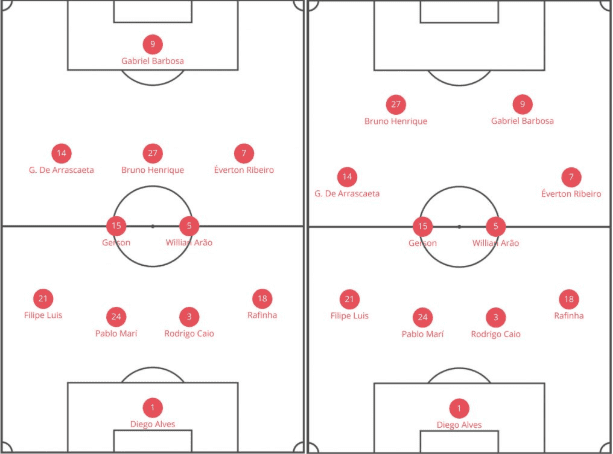
Jesus’s favourite formation is the classic 4-4-2 with high-mobility, intensive pressure high up the pitch, and good ball circulation. These attributes allow Jesus to tweak its formation to a 4-2-3-1 or a 4-3-3 on some occasions, but they all derive from the basic 4-4-2.
The starting eleven is filled with players familiar with European football. In goal, there is Valencia’s ex keeper, Diego Alves. The full-backs are Brazilian internationals Rafinha (ex-Bayern Munich) and Felipe Luis (ex-Atletico Madrid) – two attacking players that contribute to the build-up phase in attack with their experience from the top European leagues. The centre-back partnership of Rodrigo Caio and Pablo Mari is also a key aspect of Flamego’s incredible run of form, with only two opposition teams scoring more than a goal against them since Jesus took over.
The midfield is formed by two players who went through the biggest transformation under Jesus: William Arao, the defensive midfielder who showed tremendous improvement in his positioning and tactical discipline; and Gerson who, for most fans, is the heartbeat of the team due to his intensity and incredible stamina. The wide players Arrascaeta and captain Everton Ribeiro aren’t natural wingers but wide playmakers since their job is to support the triangulations from the midfield and create space for the strikers.
Lastly, the striker partnership is formed by Gabigol: 40 goals and 11 assists in 54 games, and Bruno Henrique: 34 goals and 15 assists in 58 games. This partnership is key to Jesus’ tactics due to the high mobility of the strikers, which facilitates the triangulations in the last third of the pitch.
Build-up play
Jorge Jesus’s tactics consist of fast-paced, high mobility, attractive attacking football. His 4-4-2 set-up switches to a 3-4-3 during the build-up phase. Flamengo’s nº6, Arão, drops back in between the centre-backs to allow the experience and aggressive full-backs to push forward into midfield. Thus, the 4 midfielders are Rafinha, Gerson, Arrascaeta, and Felipe Luis.
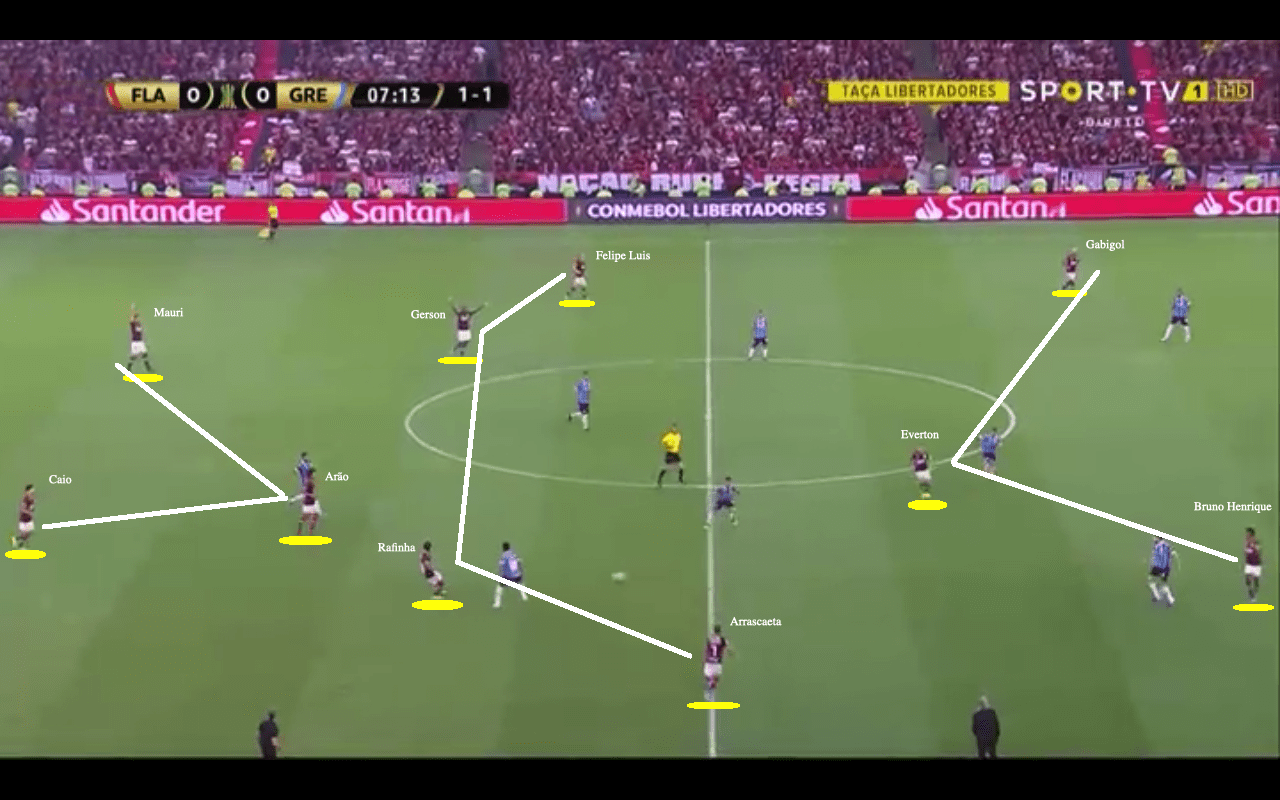
The image above shows the set-up used by Jesus in the build-up stage. Having 3 men at the back gives Flamengo good defensive solidity since it will never be overloaded by the opposition’s strikers (no teams uses more than 3 players up top). The 4-man midfield also gives width, more options, and a good defensive block in case the ball is lost in midfield. The 3 men up top are very mobile and technically gifted, meaning they are always interchanging their positioning to misplace the opposition’s defence and create spaces for the attack. One key aspect of this team is its high mobility and versatility. It means that during the attacking phase, the players are not stuck in a position. The full-backs can be seen in the centre of the midfield or the wide areas, and the strikers do the same, as seen in the picture above. The wide midfielders also have total freedom when attacking so that creating the triangles across the final third is easier.
This is because the main objective of Flamengo’s build-up is the triangulations created in the wide areas by the full-backs, the attacking midfielders and the strikers, to create overloads and attack down the flanks to cross the ball.
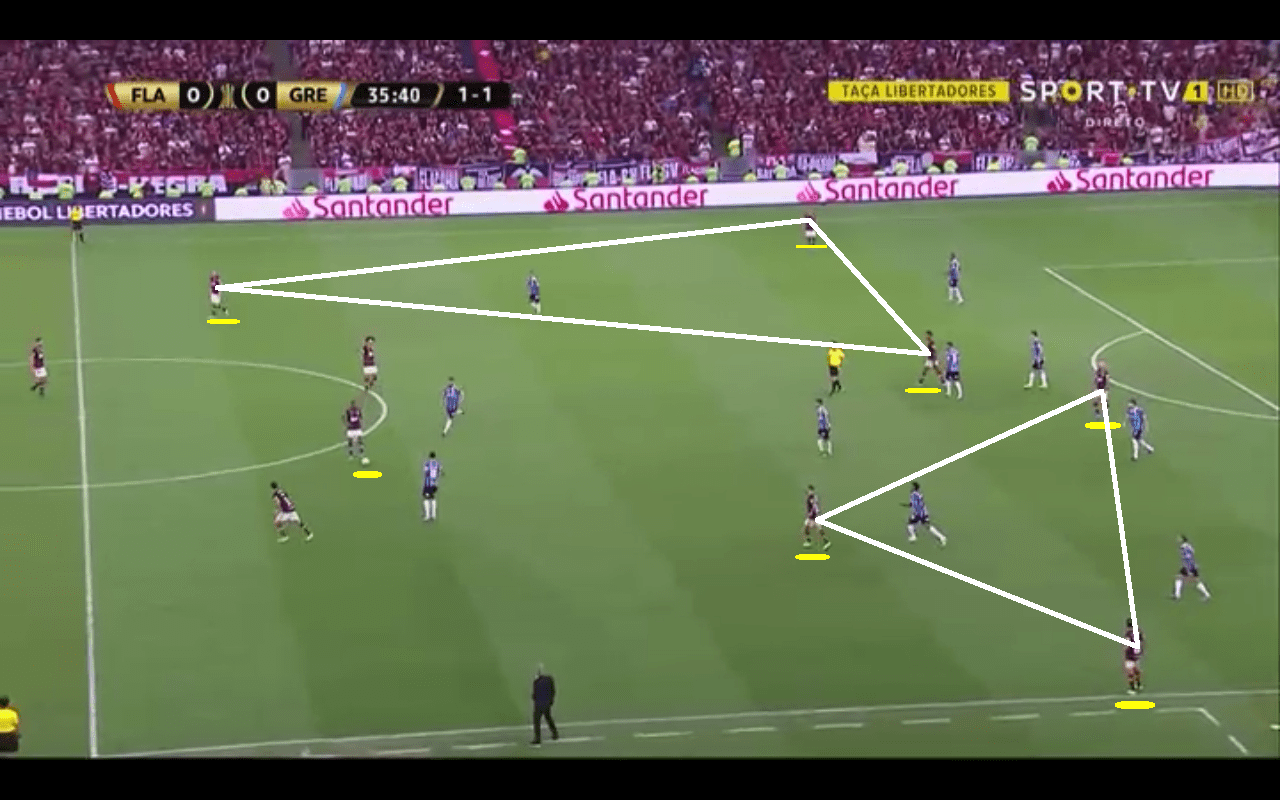
This image here gives a good example of how the Flamengo players position themselves in attack. As mentioned before, the main focus of the attacking tactics is to create triangulations in the last third of the pitch to overload the wide areas and create dangerous attacks through crosses. These triangles are visible across the full duration of the game because Jesus gives complete freedom to the attacking players, so they are free to roam around the final third of the pitch to create these triangles and give more options to their teammates.
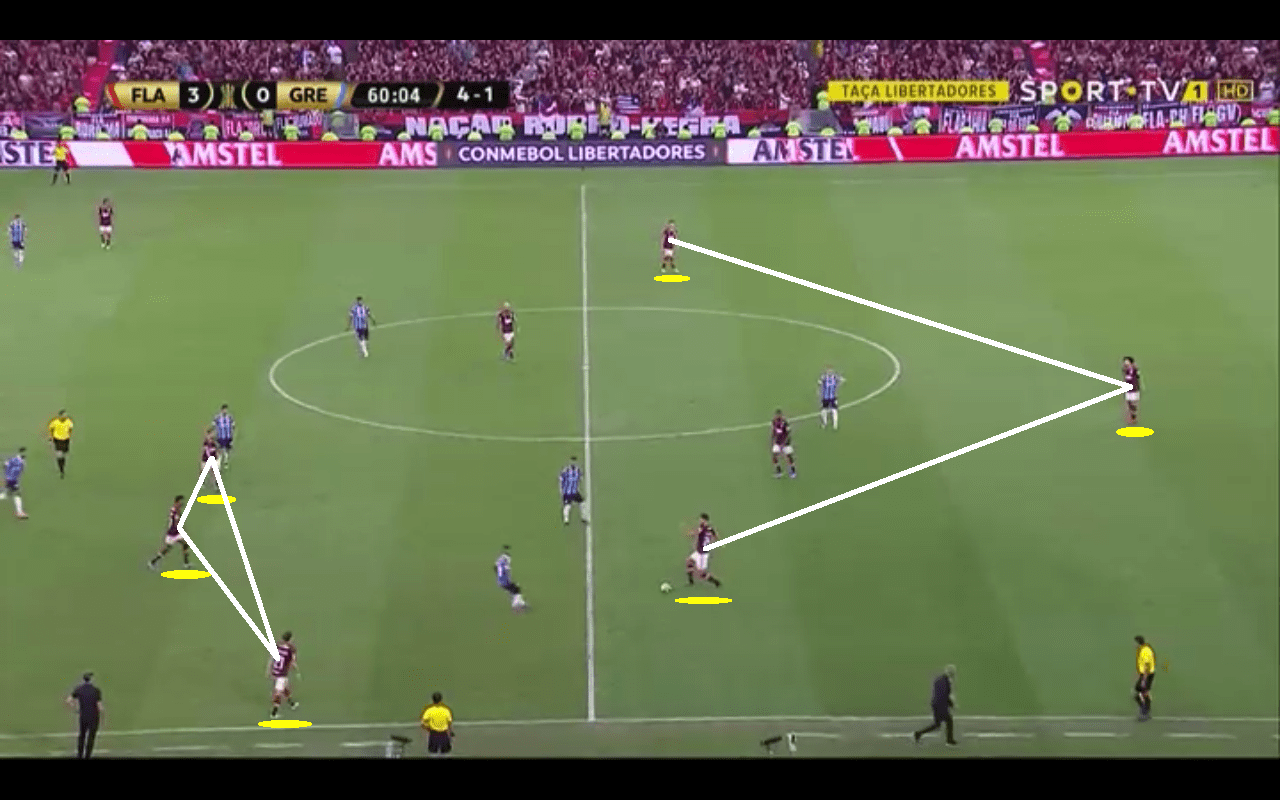
Here is an example of an overload on the left side created by Flamengo. The system of Flamengo’s attacks is to use the ball-carrying centre-backs to drive through the halfway line with the ball and lay it off to one of the three attacking players in the wide areas. The player advantage is then used by circulating the ball from one flank to the other to move the opposition, consequently creating spaces in the defence to play through passes in behind for dangerous crosses to the strikers.
These triangulations in wide areas are what creates a high ball circulation in the Flamengo attacking play since having more players around the ball creates more options, hence why Flamengo has such a high involvement rate in its attacks. This is another advantage of having full freedom in attack.
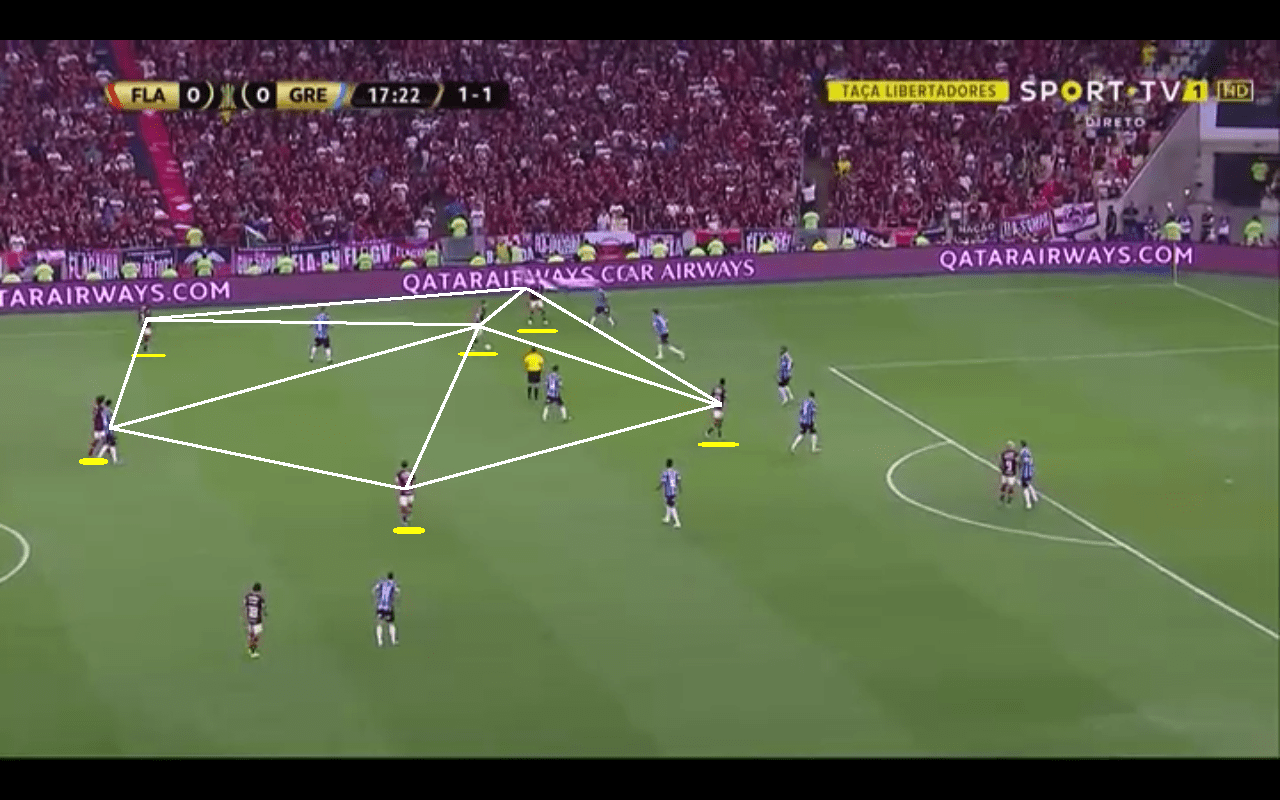
The picture above is the perfect example of a high circulation attacking strategy. The player carrying the ball has at least 5 easy options to pass to. This way the players are never at risk of losing the ball, and never at risk of getting caught on the counter-attack because if you have the ball, the opposition cannot score. Another key factor of this kind of attacking play is that even if one of the players does lose the ball by a bad pass or a good interception, there are more than enough players around to immediately pressure the opposition and win the ball back instantly.
This is one of Jesus’ most noticeable transformations in Brazilian football. He taught his players about tactical discipline and positioning, which is seen as revolutionary because most teams rely on the individual skills of their players, thus why Brazilian players are considered to be so technically gifted and are often purchased by top European clubs.
The aggressive pressing style
Flamengo’s defensive tactics are based around a high pressing style with the purpose to cut all options to force the opposition to either lose the ball or play long balls. Its defensive shape tends to be a 4-4-2 to give two solid blocks of 4 in midfield and defence so that pressing the opposition player with the ball is easier.
Despite having two defensive lines of 4 players, Flamengo mainly uses man-marking instead of zonal marking, to pressure the opposition player with the ball, forcing him to play a long ball, play it backwards or lose it altogether. Here is a perfect example of this style of pressing:
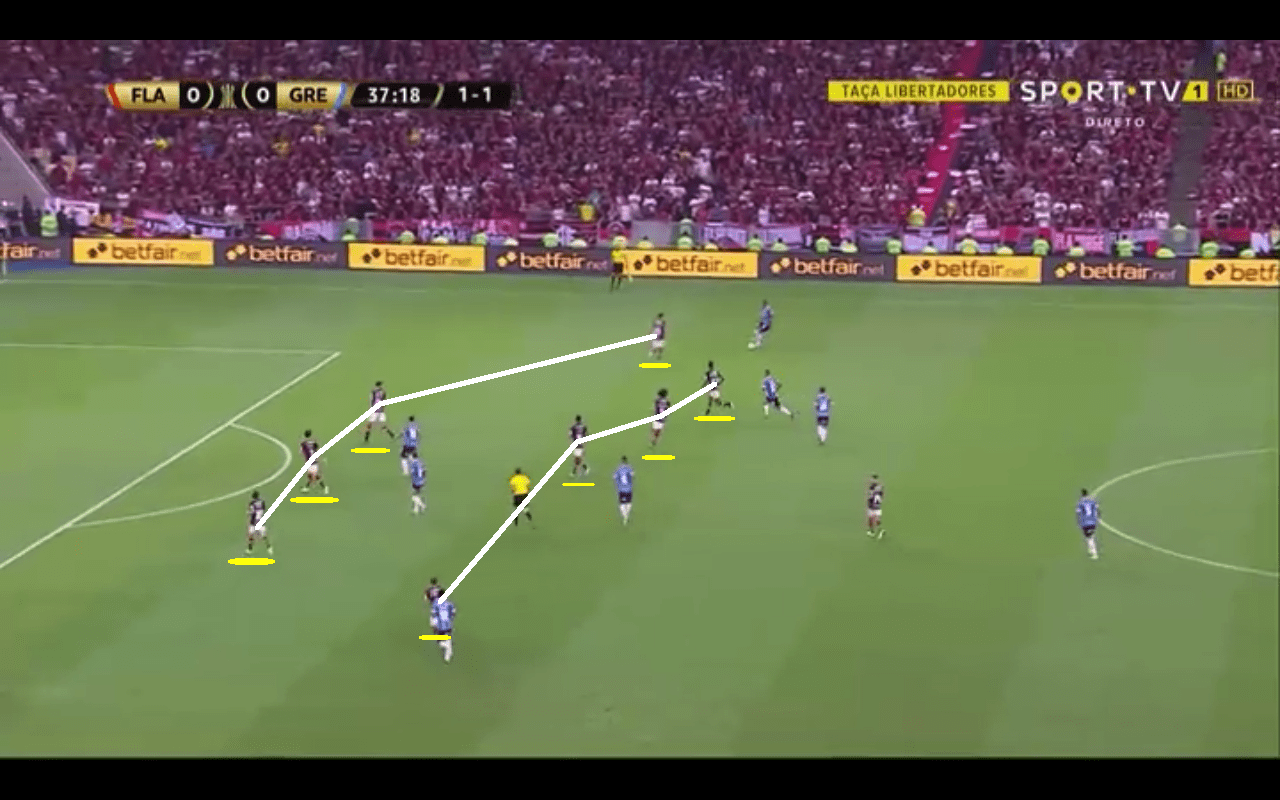
Here the two lines of four are visible. These two defensive blocks give Flamengo a solid structure at the back, which makes it hard for the opposition to play through the balls for an attack. This is why most of the goals conceded by Flamengo are on the counter since the two blocks are missing. You should also notice that each player is man-marking each opposition player as well while tracking the ball. Although man-marking is not a usual defensive tactic in modern football, Jesus uses it very efficiently because of how intensive the Flamengo players apply that pressure.
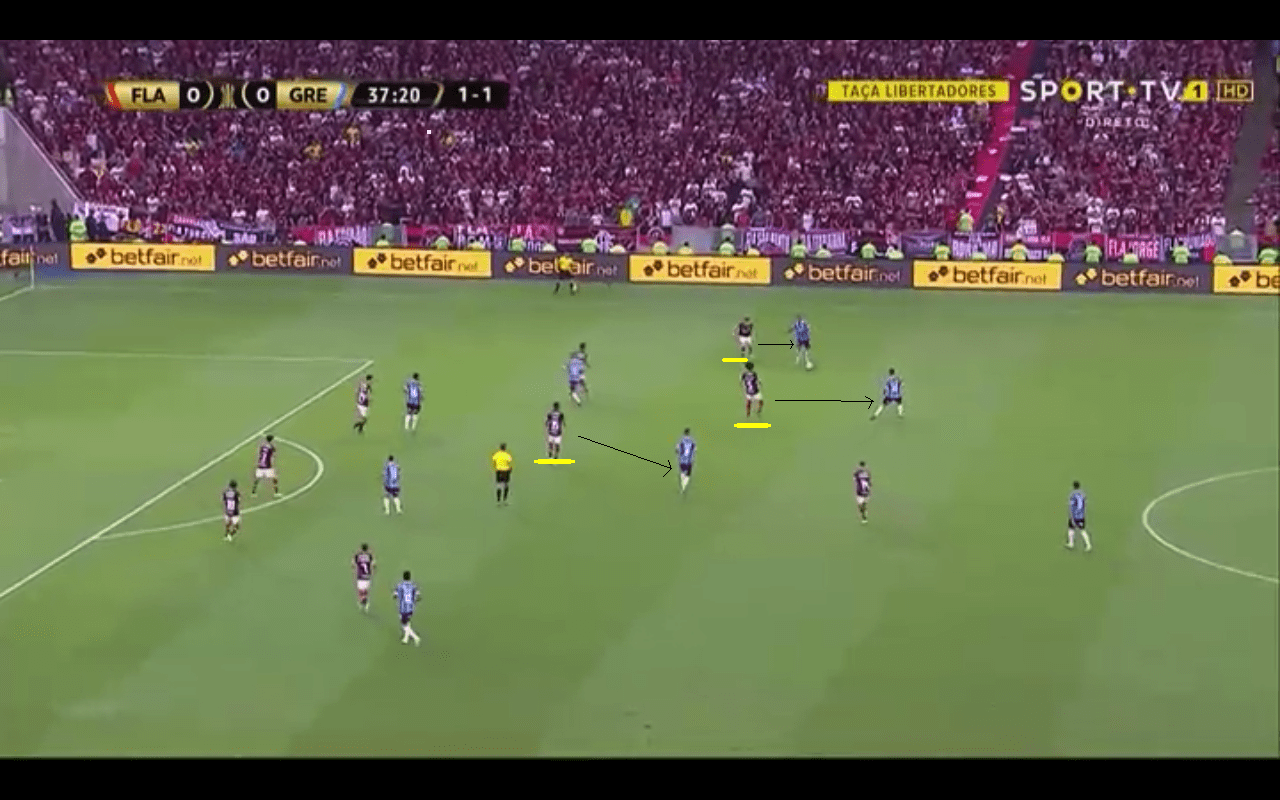
As soon as the opposition moves the ball, Flamengo begins to intensify its pressure, showcased by the arrows above, indicating the players’ movements.
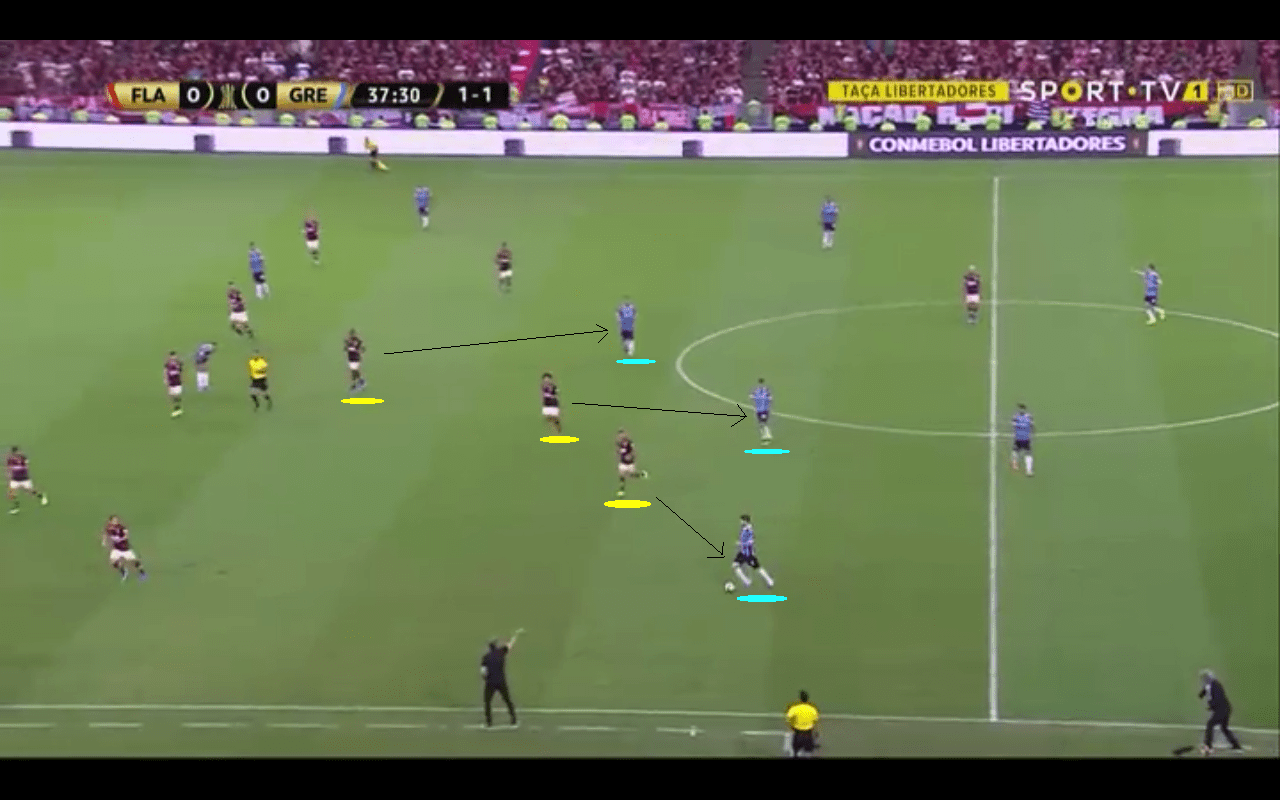
Here is once again the man-marking system implemented by Jesus. The big transformation in this new defensive system is the intensity of pressing applied by the Flamengo players. Once the ball moves, the player marking that opposition will sprint to press that player to make him either lose the ball or pass backwards.
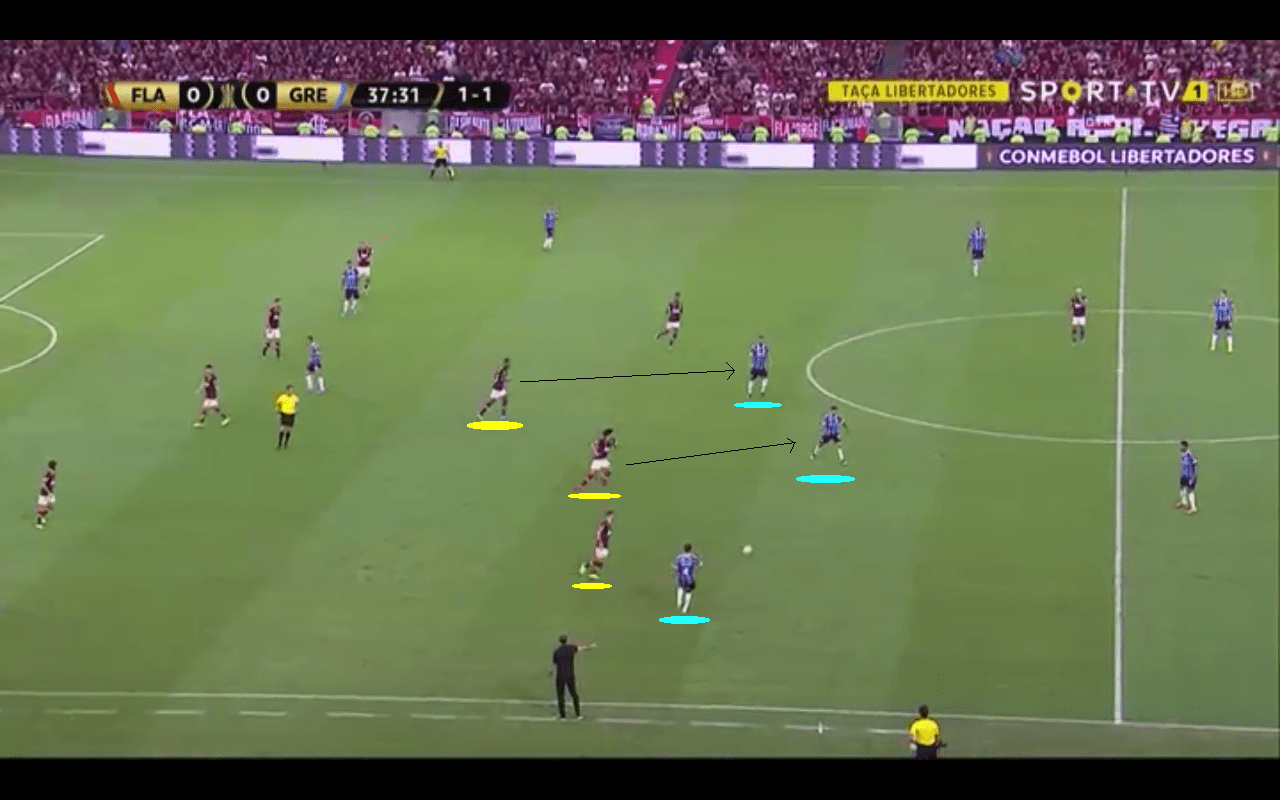
As the ball is passed, we can see Arão sprinting towards the player about to receive the ball, so he is forced to pass backwards, which is what happens (image below).
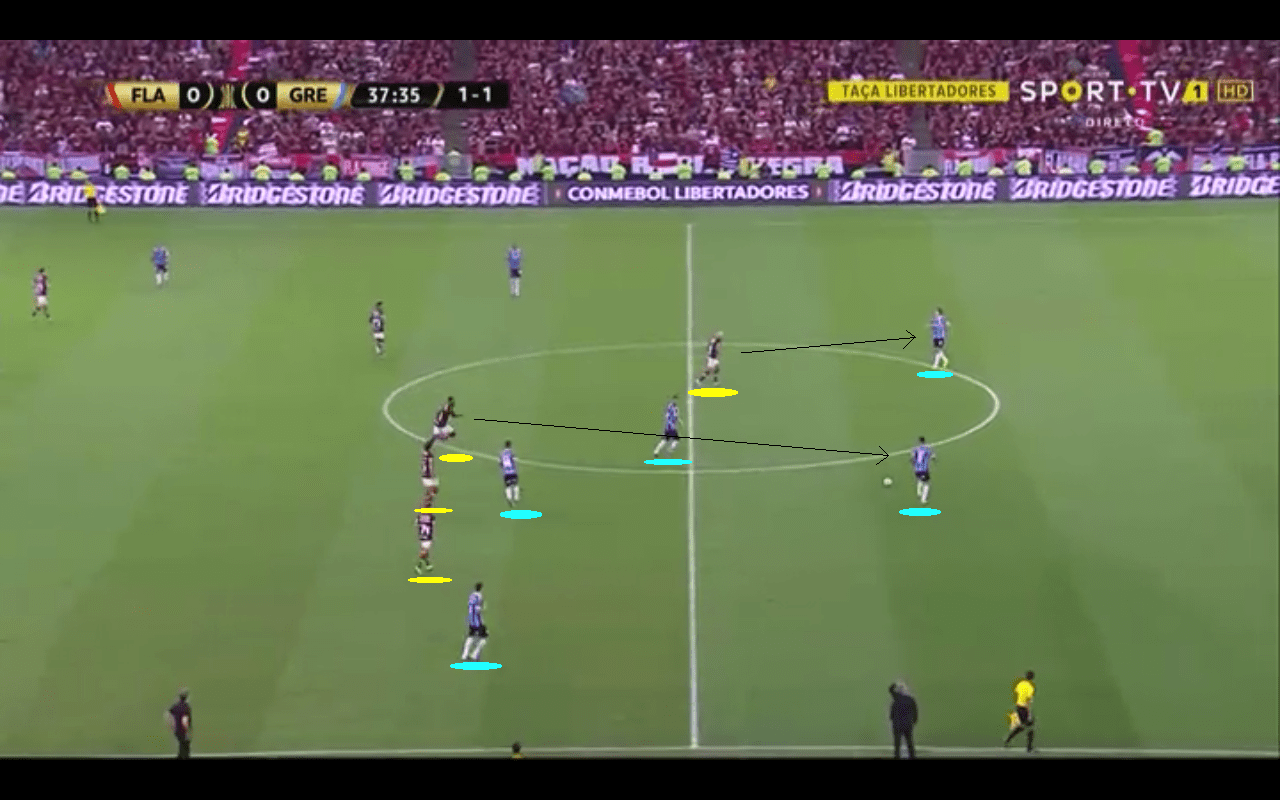
Then we see another Flamengo player sprinting forward to press the centre-back, trying to give him no time nor space to make a good decision to progress his team’s attacking play.
This type of pressing has been the tipping point between Flamengo and other teams in Latin America because it is a very unusual type of pressing over there in comparison to Europe.
Conclusion
All in all, Jorge Jesus came, saw, and conquered. He kept silent and let his work do the talking. His players believed in him from the start and through intensive training sessions and lessons on tactical knowledge and discipline, Jesus proved every doubter wrong by doing the double in a single weekend. His attacking style of play resembles Jesus’ time at Benfica where he managed to get into two consecutive Europa League finals, plus several leagues and cups.
Bringing a different tactic to the Brazilian culture was a risky move by Jesus, and every media outlet in Brazil thought the same. Nevertheless, Jesus knew what Flamengo needed to reach its goals, and arguably this change could have worked in any other team in the league due to how big the differences were. His idea of purchasing three European experienced players such as Diego Alves (goalkeeper), Rafinha and Felipe Luis (full-backs) proved to be essential for the implementation of his style of football and trusting his process and his ideas got him farther than anybody else in 30 odd years.

If you love tactical analysis, then you’ll love the digital magazines from totalfootballanalysis.com – a guaranteed 100+ pages of pure tactical analysis covering topics from the Premier League, Serie A, La Liga, Bundesliga and many, many more. Buy your copy of the November issue for just ₤4.99 here






Comments